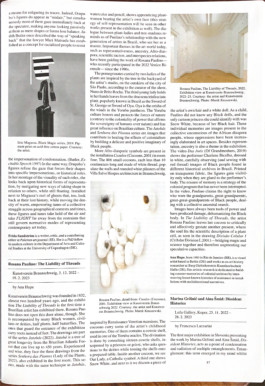Rosana Paulino: The Liability of Threads
Kunstverein Braunschweig, 3. 12. 2022 – 19. 2. 2023
Review for Magazine CAMERA AUSTRIA, https://camera-austria.at/
by Ana Hupe
Kunstverein Braunschweig was founded in 1832, almost two hundred years ago, and the exhibition The Liability of Threads is the first time a Brazilian artist has exhibited there. Rosana Paulino does not open this door alone, though. She is accompanied by many Black women, civilians or deities, half plants, half butterflies. The ones that guard the entrance of the exhibition carry roots instead of feet. The drawings are part of the series Jatobás (2022). Jatobá is a tree of great longevity from the Brazilian Atlantic Forest that can live up to 450 years. Experienced and wise, they face the three drawings from the series Senhora das Plantas (Lady of the Plants, 2022), also exhibited in the first room. This series, made with the same technique as Jatobás, watercolor and pencil, shows apprenticing plant-women bearing the artist’s own face (this strategy of self-representation will be seen in other works present in the exhibition as well). The dialogue between plant-ladies and tree-madams reminds us of Paulino’s relationship with the new generation of artists in Brazil, who see her as a master. Important themes in the art world today, such as representativeness, ancestry, Afro-diaspora, scientific racism, and interspecies relations, have been guiding the work of Rosana Paulino—who recently participated in the 2022 Venice Biennale—since the 1990s.
The pomegranates carried by two ladies of the plants are inspired by the tree in the backyard of the artist’s studio, on the outskirts of the city of São Paulo, according to the curator of the show, Nuno de Brito Rocha. The third young lady holds in her hands leaves from the dracaena trisfasciata plant, popularly known in Brazil as the Sword of St. George or Sword of Oya. Oya is the orisha of the winds in the Yoruba pantheon. The Yoruba culture honors and protects the forces of nature (contrary to the coloniality of power that affirms the sovereignty of humans over nature) and has great influence on Brazilian culture. The Jatobás and Senhoras das Plantas series are images that contribute to healing the effects of colonialism by building a delicate and positive imaginary of Black people.
More Afro-diasporic symbols are present in the installation Casulos (Cocoons, 2001) in room four. The 806 small cocoons, each less than 10 centimeters long and made of white thread, populate the walls and rounded white pilasters of the Villa Salve Hospes architecture in Braunschweig, inspired by Renaissance Venetian mansions. The cocoons carry some of the artist’s childhood memories. One of them contains a cowrie shell, used in one of the Yoruba oracles. The divination is done by consulting sixteen cowrie shells, interpreted by a priestess or priest, who asks questions to the deities while tossing the shells onto a prepared table. Inside another cocoon, we see Our Lady, a Catholic symbol. A third one shows Snow White, and next to it we discern a piece of the artist’s own hair and a white doll. As a child, Paulino did not know any Black dolls, and the only cartoon princess she could identify with was Snow White, because of her Black hair. These individual memories are images present in the collective unconscious of the African diaspora people, whose oppressions have been increasingly elaborated in art spaces. Besides representation, ancestry is also a theme in the exhibition. The video Das Avós (Of Grandmothers, 2019) shows the performer Charlene Bicalho, dressed in white, carefully observing (and sewing with red thread) images of Black people found in different historical archives in Brazil. Printed on transparent fabric, the figures gain visibility only when they are glued to the performer’s body. The erasure of memory is a strategy of the colonial program that has never been interrupted. In the video, Paulino claims the right to know who were the grandparents, great-grandparents, great-great-grandparents of Black people, dealing with a collective ancestral search.
Images have always been tools of power and have produced damage, dehumanizing the black body. In The Liability of Threads, the artist Rosana Paulino leaves her cocoon to critically and affectively gestate another present, where the soul fits the scientific description of a plant cell, as seen in the drawing Divisão Celular I (Cellular Division I, 2001)—bridging magic and science together and therefore augmenting our speculative capacities.
Ana Hupe born 1983 in Rio de Janeiro, Brazil, is a visual artist based in Berlin and works as an art history researcher at Burg Giebichenstein Kunsthochschule Halle, Germany. Her artistic research is dedicated to building counter-memories of colonial archives by interweaving lesser known histories of resistance in installations with multidirectional narratives. She received her Ph.D. in fine arts from the Federal University of Rio de Janeiro in 2016, after studying for one year at University of the Arts (UdK) Berlin. In 2023 she is publishing the book Footnotes to Triangular Cartographies (K Verlag).
Hupe applies various techniques, such as lens-based media, texts, printmaking,and sculpture, and her works are in the collections of Essex Collection of Art from Latin America (ESCALA), UK; MAR, Museum of Art Rio; Gilberto Chateaubriand’s Collection at Museum of Modern Art, Rio de Janeiro; and, Institute for National Historical and Artistic Inheritance (IPHAN), Brazil.
https://kunstvereinbraunschweig.de/en/information/institution/

